Numerical study of the active earth pressure distribution on cylindrical shafts using 2D finite difference code
Abstract
The present paper examine the distribution of the active pressure on a circular shaft embedded in granular material subjected to radial displacement. The deformation problem was solved under axisymmetric conditions using explicit finite difference code FLAC (Fast Lagrangian Analyses of Continua). Based on the numerical results, the distribution of the active pressure with increasing excavation depth is non-linear for all interface angle of the shaft, for different diameters and height of the shaft also for the all friction angles of the soil. When friction angle of the soil that are less than, or equal to 10° the active pressure is linear. These results are summarized and compared against previously published theoretical solutions and experimental results.
J. Appl. Eng. Sci. Technol. (JAEST - ISSN 2352-9873) is a peer-reviewed quarterly journal dedicated to the applied engineering sciences and technology. The JAEST provides immediate open access to its content on the principle that making research freely available to the public supports a greater global exchange of knowledge.
There is no submission or publication fee for papers published in the JAEST.
Authors who publish in the JAEST agree to the following terms:
- Authors retain copyright and grant the journal right of first publication with the work simultaneously licensed under a Creative Commons Attribution License that allows others to share the work with an acknowledgement of the work's authorship and initial publication in the JAEST.
- Authors are able to enter into separate, additional contractual arrangements for the non-exclusive distribution of the journal's published version of the work (e.g., post it to an institutional repository or publish it in a book), with an acknowledgement of its initial publication in the JAEST.
- Authors are permitted to post their work online (e.g., in institutional repositories or on their website) prior to and during the submission process, as it can lead to productive exchanges, as well as earlier and greater citation of published work (See The Effect of Open Access). Any such posting made before acceptance and publication of the Work shall be updated upon publication to include a reference to the JAEST and a link to the online abstract for the final published Work in the Journal.






